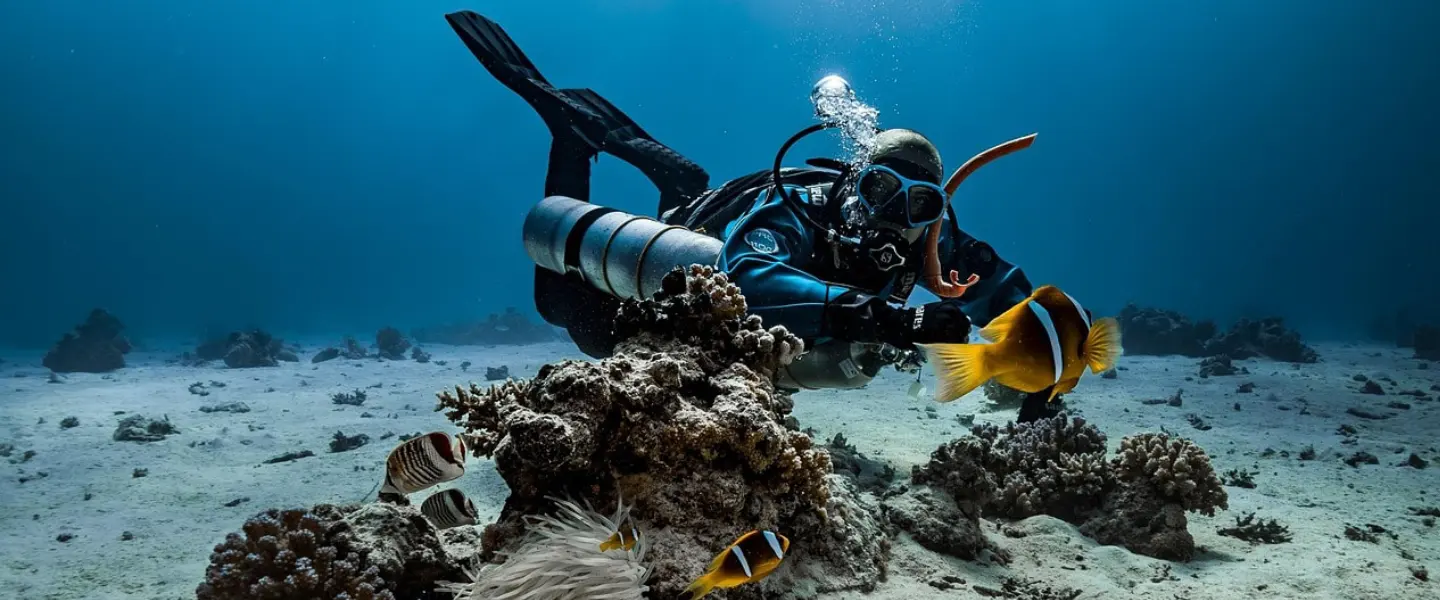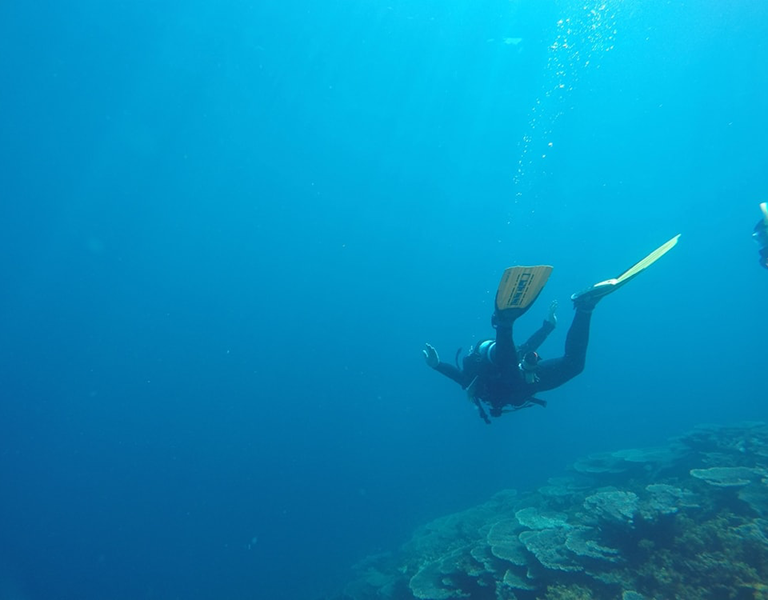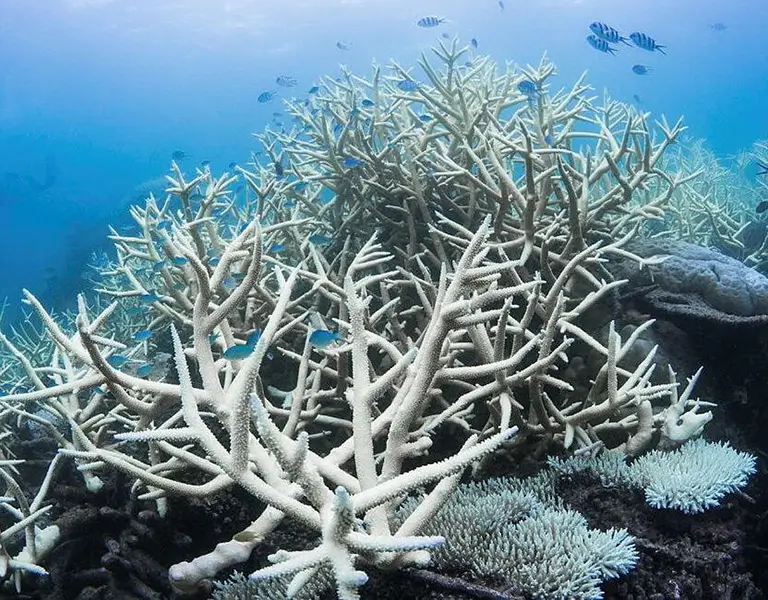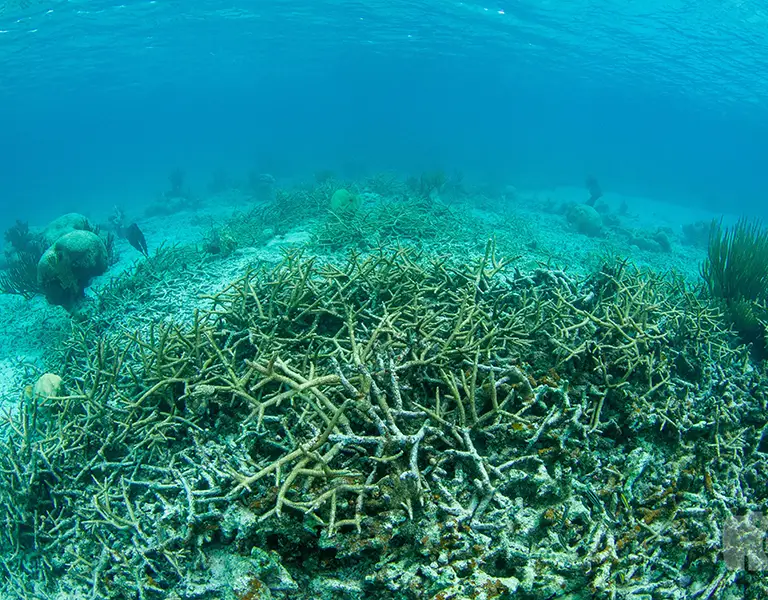Coral fragmentation has emerged as a vital technique in the global effort to save our planet’s coral reefs from extinction. As coral ecosystems face unprecedented threats, this innovative approach offers hope for preserving these underwater wonders for future generations.
Key Takeaways
- Coral breakage stimulates new coral growth, supporting the restoration of degraded reefs more efficiently than natural processes alone
- Combining fragmentation with land-based nurseries creates climate-resilient corals better adapted to survive warming oceans
- Micro-fragmentation techniques have revolutionized restoration of massive corals previously considered too slow-growing for restoration projects
- Advances in coral propagation technologies are dramatically increasing restoration scale and genetic diversity
- Community-based restoration efforts utilizing fragmentation techniques are creating sustainable solutions that benefit local ecosystems and economies
Understanding Coral splitting

Coral splitting represents nature’s remarkable capacity for regeneration. In its most basic form, fragmenting is an asexual reproduction method where small pieces of coral colonies—called fragments—can grow into new, genetically identical colonies. This process occurs naturally when storms or other disturbances break pieces from parent colonies, which then reattach to suitable substrate and develop into new colonies on coral reefs.
Marine scientists have harnessed this natural ability to accelerate coral restoration efforts worldwide. By deliberately creating coral fragments in controlled environments, researchers and restoration practitioners can produce thousands of new coral colonies from a limited amount of source material.
“Fragmentation allows us to work with coral’s natural recovery processes, essentially giving nature a boost when coral reefs face degradation beyond their natural healing capacity,” explains Dr. Emma Gibbons, marine biologist and restoration specialist at the University of Miami. “This technique forms the backbone of most active reef restoration programs worldwide.”
The science behind fragmentation is elegantly simple but powerful. Corals are colonial organisms composed of thousands of individual polyps. When a fragment breaks off with live tissue intact, these polyps can continue growing and multiplying, eventually forming a new colony genetically identical to the parent. This clonal propagation preserves the exact genetic makeup that allowed the parent colony to thrive in its environment.
The Urgent Need for Reef Rehabilitation
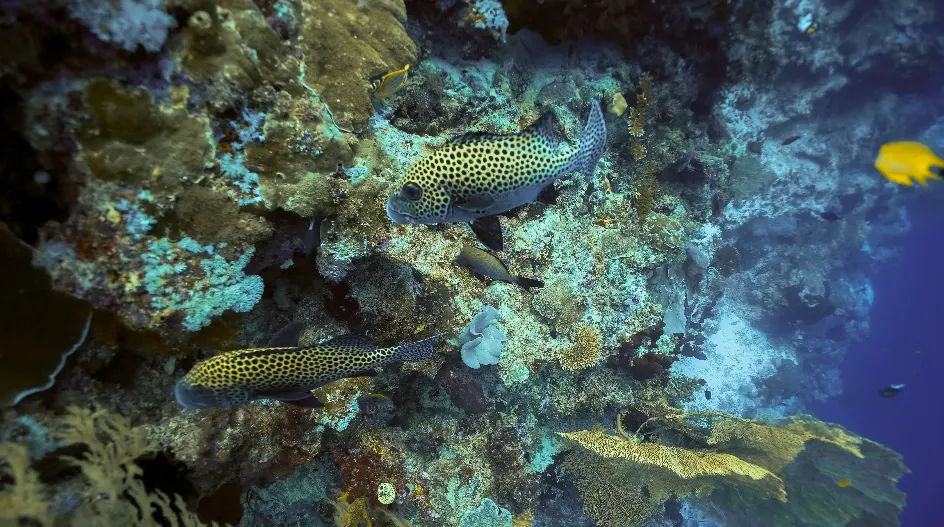
Our planet’s coral reefs face an existential crisis. These magnificent ecosystems, often called the “rainforests of the sea,” support approximately 25% of all marine species while covering less than 1% of the ocean floor1. Yet despite their ecological significance, coral reefs are disappearing at an alarming rate.
The global decline of coral reefs has accelerated dramatically in recent decades. Climate change-induced ocean warming has triggered devastating mass coral bleaching events, where corals expel their symbiotic algae and often die. A staggering 50% of the world’s coral reefs have already been lost, with projections suggesting 90% could disappear by 2050 without intervention2.
Reef Rehabilitation through fragmentation offers a crucial pathway for combating this decline. While addressing climate change remains the ultimate priority for reef conservation, active restoration provides a vital stopgap to preserve reef ecosystems while broader environmental challenges are addressed.
Reef building corals create the three-dimensional calcium carbonate structures that form the foundation of these incredible ecosystems. By focusing fragmentation efforts on these key species, restoration practitioners can rebuild reef architecture that supports biodiversity across the entire ecosystem.
The Science of oral fracturing
Coral dislodging works by harnessing the natural regenerative abilities of coral organisms. Stony corals, the primary reef building corals, have remarkable capacity to regrow from small fragments as small as one centimeter in length under optimal conditions.
The process begins with careful collection of small portions of healthy parent colonies, typically 5-10% of the colony to ensure minimal impact. These fragments are then attached to artificial substrates—often made of cement, ceramic, or recycled materials—to provide a stable surface for growth.
“What makes fragmentation particularly valuable is how it accelerates coral growth rates,” notes Samuel Teicher, co-founder of Coral Vita. “Fragment edges experience enhanced calcification, essentially growing new skeleton faster than undamaged portions of a colony would naturally.”
This accelerated growth relates directly to surface area dynamics. When a coral reef is fragmented, the ratio of tissue surface area to volume increases substantially. This increased surface area allows for more rapid calcium carbonate deposition—the process by which corals build their skeletal structure.
Environmental factors significantly influence fragmentation success. Water temperature, light availability, water motion, and nutrient levels must all be carefully monitored and managed to optimize growth rates. In land-based nursery settings, these parameters can be controlled precisely to create ideal conditions for rapid growth.
Advances in Fragmentation Techniques
Coral rehabilitation science science has evolved considerably since the first basic underwater coral gardening efforts. Today’s fragmentation approaches incorporate sophisticated technologies and methodologies that dramatically increase efficiency and effectiveness.
Micro-fragmentation: Revolutionizing Massive Coral Restoration
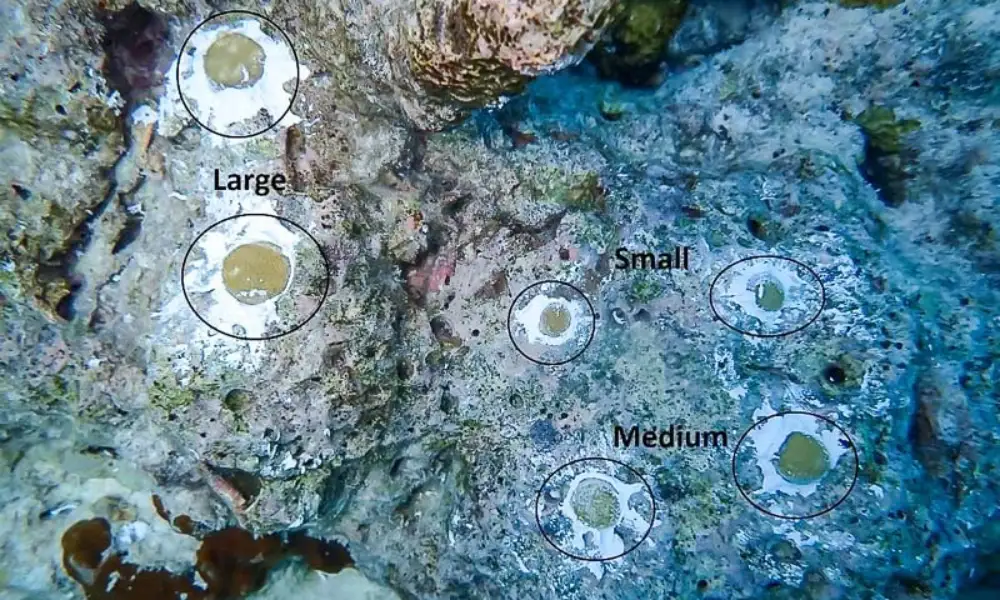
Among the most significant breakthroughs in fragmentation science is the development of micro-fragmentation techniques. This process, pioneered by Dr. David Vaughan at Mote Marine Laboratory, involves cutting corals into extremely small fragments—often just a few polyps in size.
Micro-fragmentation has revolutionized restoration of massive corals like brain, boulder, and star corals. These slower growing corals had previously been considered impractical for restoration due to their typically slow growth rates. However, when micro-fragmented, these species demonstrate noticeably accelerated growth compared to typical natural development rates3.
The technique works by triggering an extraordinary healing response. When cut into tiny pieces (1-2 cm²), corals direct energy toward rapid tissue expansion to heal the newly created edges. Researchers have documented growth rates of 10-25 cm² per year for species that typically grow just 0.5-2 cm² annually in natural settings4.
“Micro-fragmentation has completely transformed our ability to restore massive corals,” explains Dr. Natalie Calvin, director of experimental marine biology at Coral Vita. “Species that might take decades to reach reproductive size can now contribute to reef structure in just years.”
Coral Trees: Scaling Midwater Nurseries
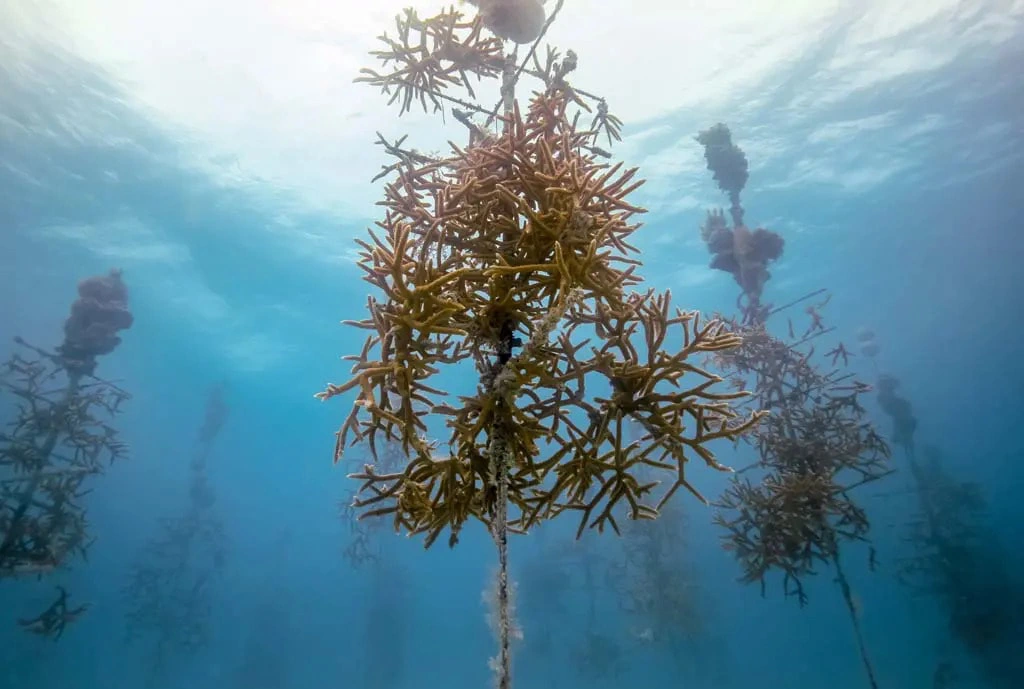
For branching coral species like Acropora spp., the development of “coral trees” has dramatically increased production capacity. These structures—typically constructed from PVC pipes configured in tree-like arrangements—suspend coral fragments in the water column, providing ideal growing conditions with 360° water flow and optimized light exposure.
A single coral tree can support hundreds of fragments simultaneously while requiring minimal seafloor footprint. This design minimizes maintenance requirements while maximizing growth rates, with many coral species achieving 10-15 cm of linear growth annually5.
Land-Based Nurseries: Controlled Environment Advantages
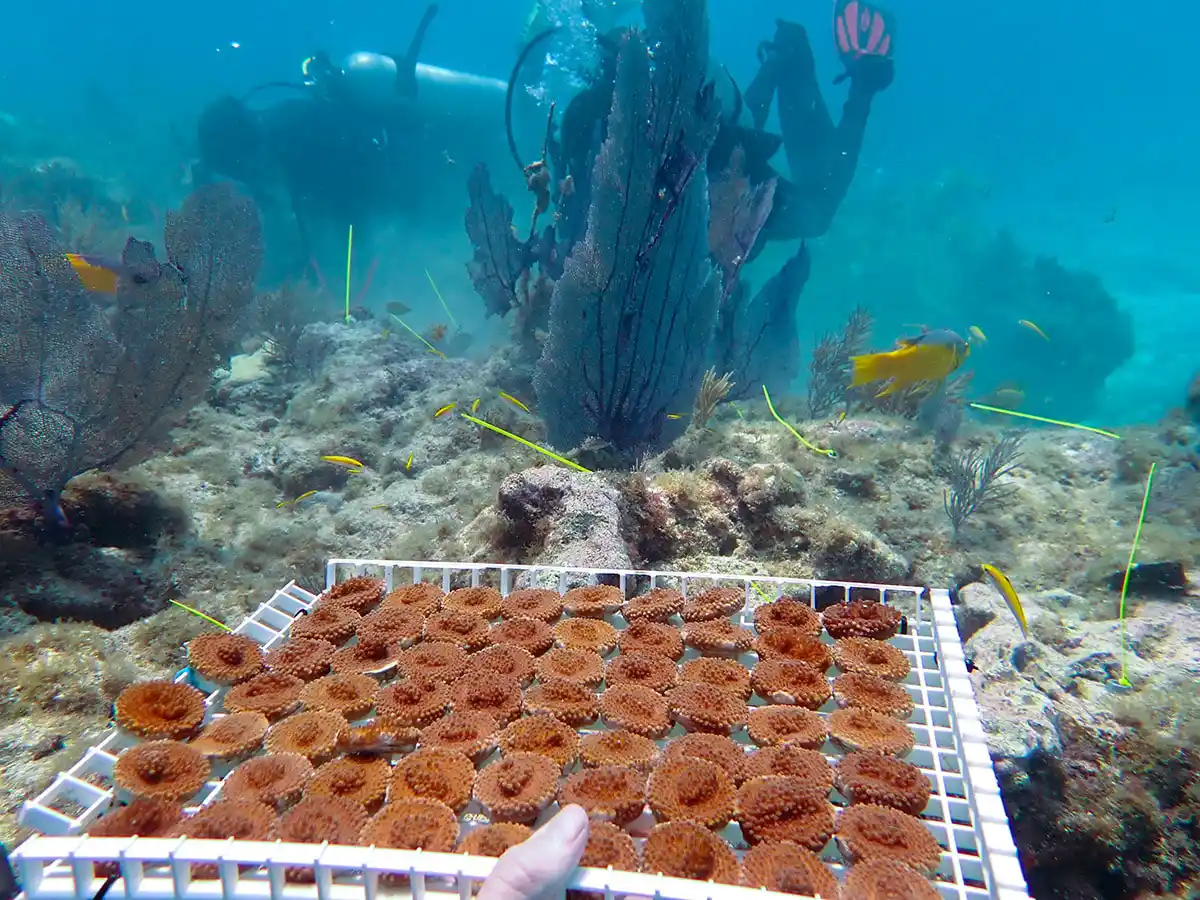
While underwater nurseries were the initial standard for fragmentation efforts, land-based facilities offer significant advantages for certain aspects of coral propagation. These facilities provide unparalleled environmental control, allowing practitioners to optimize temperature, light, water chemistry, and feeding regimes.
Land-based nursery operations enable year-round production regardless of seasonal ocean conditions. They also offer protection from storms, predators, and disease outbreaks that can devastate ocean-based nurseries.
“The controlled environment of land-based facilities creates opportunities for assisted evolution approaches that wouldn’t be possible in ocean settings,” notes Teicher. “We can gradually expose corals to elevated temperatures or altered chemistry conditions, essentially training them to withstand future ocean conditions.”
Genetic Considerations in Fragmentation
While fragmentation provides remarkable efficiency for scaling coral production, thoughtful genetic management remains essential for successful reef restoration. Because fragmentation produces genetically identical clones, restoration practitioners must carefully balance production efficiency with genetic diversity considerations.
Maintaining genetic diversity within restoration projects helps ensure population resilience. Diverse coral populations possess greater adaptive capacity to respond to environmental stressors and disease outbreaks. Different genotypes (genetic individuals) often demonstrate varying tolerance to temperature extremes, acidification, and pathogens.
“Best practices in fragmentation-based restoration now incorporate careful genetic tracking systems,” explains Dr. Calvin. “We catalog each unique genotype and intentionally mix multiple genotypes within outplanting sites to maximize diversity.”
Modern restoration programs typically collect fragments from dozens or even hundreds of parent colonies from the same species, creating genotype libraries that preserve the genetic diversity of local reef systems. By mixing these genotypes in restoration sites, practitioners create populations with greater adaptive potential.
Some advanced programs complement fragmentation with sexual reproduction approaches. During coral spawning events—when corals release eggs and sperm into the water column—practitioners collect spawn from diverse parent colonies. The resulting larvae represent new genetic combinations, further enhancing population diversity when incorporated into restoration efforts.
From Nursery to Reef: Outplanting Fundamentals

The journey from fragmentation to established reef colonies culminates in the outplanting process—transferring nursery-grown corals fragments to degraded reef sites. This critical phase requires careful planning and execution to ensure survival and ecological integration.
Site selection represents perhaps the most important decision in the outplanting process. Ideal restoration sites maintain suitable environmental conditions while addressing the factors that caused initial degradation. Water quality, temperature patterns, current flow, herbivore populations, and human use patterns all factor into site evaluation.
“We conduct extensive site assessments before any outplanting begins,” notes Maria Rodriguez, restoration coordinator at Reef Renewal International. “Historical data, water quality testing, and community ecological surveys help identify locations where outplanted corals fragments have the highest probability of survival.”
Attachment methods have evolved substantially as the field has matured. Early efforts relied primarily on underwater epoxy or cement to secure fragments to reef substrate. Modern approaches include specialized masonry nails, cable ties with base plates, and various engineered attachment systems designed to maximize stability while minimizing handling time.
Timing considerations significantly impact outplanting success. Scheduling work during optimal seasonal windows—avoiding extreme temperature periods, storm seasons, and known bleaching risk timeframes—can dramatically improve survival rates. Many programs achieve 70-90% survival when outplanting occurs during ideal conditions, compared to as low as 30% during challenging periods6.
Post-outplanting monitoring provides critical feedback for program improvement. Regular surveys documenting coral fragment survival rates, growth patterns, and ecological integration help practitioners refine techniques and protocols. Most programs conduct monitoring at 1-month, 6-month, and 1-year intervals, with some maintaining longer-term datasets spanning 5+ years.
Micro-fragmentation and Fusion: Accelerating Massive Coral Growth
The innovative technique of micro-fragmentation followed by fusion represents one of the most significant breakthroughs in coral reef ecosystems restoration science. This approach, particularly valuable for massive corals with typically slow growth rates, has transformed restoration possibilities for species previously considered impractical for active restoration.
The process begins with cutting parent colonies into extremely small fragments—often just 1 cm²—which triggers an accelerated growth response as the tiny fragments heal their cut edges. These micro-fragments are then cultured in land-based or ocean nurseries until they reach approximately 4-6 cm in diameter.
The magic happens during the fusion phase. When micro-fragments from the same genotype (genetic individual) are placed in close proximity on appropriate substrate, they recognize each other as genetically identical and fuse together, forming a single continuous colony. This fusion process allows practitioners to rapidly create sizeable colonies that might otherwise take decades to develop naturally.
“We’ve documented brain corals reaching 15-20 cm diameter within 2-3 years using micro-fragmentation and fusion,” explains Dr. Calvin. “The same growth might take 15-20 years under natural conditions.”
This technique has proven particularly valuable for species like Orbicella faveolata (mountainous star coral), Diploria labyrinthiformis (grooved brain coral), and Pseudodiploria strigosa (symmetrical brain coral)—massive species that provide critical three-dimensional habitat complexity but typically grow just millimeters per year.
Beyond the growth acceleration benefits, the micro-fragmentation and fusion approach conserves genetic diversity by maximizing colony production from limited donor material. From a single donor colony the size of a dinner plate, practitioners can generate hundreds of micro-fragments, potentially restoring tens of square meters of reef with genetically identical material.
Coral Trees: Scaling Midwater Nurseries

The development of suspended midwater nursery systems, commonly called “coral trees,” has dramatically increased the efficiency and scalability of fragmentation-based restoration. These innovative structures have become standard components in restoration programs worldwide.
Coral trees typically consist of a vertical PVC pipe anchored to the seafloor and buoyed by a subsurface float. Horizontal “branches” extend from the central trunk, providing attachment points for dozens to hundreds of coral fragments. This design suspends corals in the water column, offering optimal flow and light exposure while minimizing contact with seafloor predators and sediment.
“The beauty of coral trees lies in their simplicity and effectiveness,” explains James Monroe, field operations director at Coral Restoration Foundation. “A small team can deploy and maintain dozens of trees, each supporting hundreds of fragments. The scale becomes transformative.”
The advantages of this approach include:
- Enhanced growth rates: Suspended fragments receive 360° water flow, optimizing nutrient delivery and waste removal while preventing sediment accumulation that can stress corals.
- Simplified maintenance: The suspended design allows for easy cleaning with brushes to remove algae and other fouling organisms that compete with corals for resources.
- Storm resilience: During high-energy weather events, the flexible structures move with wave action rather than breaking, reducing damage compared to rigid seafloor nurseries.
- Cost-effectiveness: Using simple materials like PVC pipe, monofilament line, and basic hardware keeps construction costs accessible for programs with limited budgets.
- Scalability: Nursery capacity can be incrementally expanded by adding additional trees to existing arrays with minimal additional infrastructure.
Most coral tree nurseries focus on branching coral species—particularly Acropora cervicornis (staghorn coral) and Acropora palmata (elkhorn coral) in Caribbean contexts, or various Acropora and Pocillopora species in Indo-Pacific regions. These fast-growing branching corals respond exceptionally well to the suspended cultivation approach.
Advanced coral tree nursery arrays can produce tens of thousands of outplant-ready fragments annually. The Coral Restoration Foundation, which pioneered this approach, maintains nurseries in the Florida Keys containing over 500 coral trees that collectively grow more than 50,000 corals at any given time7.
Land-Based Nurseries: Controlled Environment Advantages
While ocean-based nurseries represented the initial standard for Coral rehabilitation, land-based facilities offer significant advantages that make them increasingly important components of comprehensive restoration programs.
Land-based nurseries provide unparalleled environmental control, allowing practitioners to fine-tune parameters including:
- Temperature: Maintaining optimal growth temperatures while avoiding stress thresholds
- Light: Adjusting intensity and spectrum to maximize photosynthetic efficiency
- Water chemistry: Controlling pH, alkalinity, calcium, and nutrient levels
- Water flow: Optimizing circulation patterns for feeding and waste removal
- Feeding regimes: Supplementing natural photosynthesis with targeted nutrition
“The controlled environment of a land-based facility creates opportunities for scientific advances that wouldn’t be possible in ocean settings,” explains Teicher. “We can experiment with conditions, implement assisted evolution approaches, and produce corals specifically adapted to future ocean conditions.”
Beyond environmental control, land-based facilities offer practical advantages including:
- Year-round production: Operations continue regardless of seasonal ocean conditions, storms, or thermal stress events
- Physical protection: Corals remain safe from storms, predators, and disease outbreaks that can devastate ocean nurseries
- Accessibility: Technicians can easily monitor and maintain corals without diving operations
- Research integration: Controlled settings facilitate experimental work alongside production
- Visitor engagement: Facilities can incorporate educational components, raising awareness and generating support
Land-based nurseries play particularly important roles in spawning and sexual reproduction efforts. The controlled environment allows practitioners to precisely manage conditions for spawning induction, fertilization, and larval development—processes that benefit tremendously from stable, optimized parameters.
Many leading Coral rehabilitation organizations now implement hybrid approaches, maintaining both land-based and ocean-based nursery components to leverage the unique advantages of each system. This integrated strategy maximizes production capacity while creating resilience within the restoration program itself.
Genetic Diversity and Resilience Building
While fragmentation offers remarkable efficiency for scaling coral production, thoughtful genetic management remains essential for restoration success. Because fragmentation produces genetically identical clones, practitioners must intentionally incorporate diversity considerations into program design.
“Genetic diversity serves as nature’s insurance policy,” explains Dr. Alexandra Gutiérrez, coral genetics specialist. “Different genotypes often show varying tolerance to heat stress, disease resistance, growth rates, and reproductive capacity. This variation provides essential resilience against uncertain future conditions.”
Best practices in fragmentation-based restoration now incorporate several strategies to maintain and enhance genetic diversity:
- Diverse collection: Gathering fragments from numerous wild donor colonies (often 30+ per species) to capture natural population diversity
- Genotype tracking: Maintaining detailed records of each genetic individual throughout the nursery phase and into outplanting
- Intentional mixing: Distributing multiple genotypes within each restoration site rather than creating single-genotype patches
- Performance monitoring: Tracking survival, growth, and reproduction by genotype to identify particularly resilient individuals
- Integration with sexual reproduction: Complementing fragmentation with spawning and larval propagation to generate new genetic combinations
Recent research has demonstrated that corals with certain genetic profiles demonstrate enhanced resilience to thermal stress, acidification, and disease. By incorporating these naturally resilient genotypes into restoration efforts, practitioners can potentially “boost” the adaptive capacity of restored reef areas.
“We’re not genetically modifying corals,” clarifies Dr. Calvin. “Rather, we’re identifying naturally occurring resilient individuals and strategically utilizing them in restoration—essentially accelerating natural selection processes that would happen too slowly to keep pace with current environmental changes.”
This approach, sometimes called assisted evolution, represents a middle ground between pure restoration and more interventionist approaches like selective breeding or genetic modification. By working with natural genetic diversity while intentionally selecting for resilience, practitioners aim to bridge the gap between current ocean conditions and the projected challenging future environment.
Growth Rates and Monitoring Success
Understanding fragmentation outcomes requires systematic monitoring protocols that track key metrics through time. Well-designed monitoring programs provide essential feedback for technique refinement while documenting ecological returns on restoration investments.
Growth rates vary substantially across coral species, reflecting their diverse life history strategies. Fast-growing branching species may achieve 10-15 centimeters of linear extension annually under optimal nursery conditions. By contrast, massive species may increase surface area by just a few square centimeters per year, though micro-fragmentation techniques can accelerate this considerably.
“We track multiple growth metrics depending on coral morphology,” explains Rodriguez. “Linear extension works well for branching species, while surface area measurements better capture growth patterns of massive and encrusting forms.”
Beyond simple growth measurements, comprehensive monitoring programs assess:
- Survival rates: Tracking the percentage of outplanted fragments that establish successfully
- Health indicators: Documenting tissue condition, coloration, and polyp expansion
- Reproduction: Monitoring for spawning activity or evidence of asexual propagation
- Ecological integration: Assessing interactions with fish, invertebrates, and other reef organisms
- Reef service provision: Measuring structural complexity, shoreline protection, or other ecological functions
Statistical analyses reveal patterns in restoration outcomes, helping practitioners identify the most effective techniques for specific contexts. Programs with robust monitoring components typically demonstrate continuous improvement in survival rates and ecological outcomes as techniques are refined based on data feedback.
“The most valuable monitoring programs maintain consistent data collection over extended timeframes,” notes Dr. Gibbons. “Three to five years of post-outplanting data provides true insight into long-term restoration success, though even one-year monitoring yields valuable information for program improvement.”
Combining Fragmentation with Sexual Reproduction
While fragmentation provides a powerful tool for rapidly scaling coral production, the most sophisticated restoration programs now combine this approach with sexual reproduction techniques. This integrated strategy balances the efficiency of asexual propagation with the genetic advantages of sexual recombination.
Sexual reproduction in corals occurs primarily through broadcast spawning—the synchronized release of eggs and sperm into the water column. This process creates new genetic combinations, potentially producing offspring with enhanced adaptation to changing environmental conditions.
“Sexual reproduction introduces genetic variation that simply cannot be achieved through fragmentation alone,” explains Dr. Gutiérrez. “New genetic combinations may include individuals better adapted to warmer temperatures or more resistant to emerging diseases.”
Advanced restoration programs implement several approaches to incorporate sexual reproduction:
- Spawning collection: During natural spawning events, practitioners collect gametes (eggs and sperm) from diverse parent colonies, conduct controlled fertilization, and rear the resulting larvae
- Larval propagation: Developing larvae are settled onto appropriate substrates in land-based facilities, then transferred to nurseries or directly to restoration sites once established
- Selective breeding: Intentionally crossing parent colonies with desirable traits (such as heat tolerance) to potentially enhance offspring resilience
- Cryopreservation: Banking coral sperm samples to preserve genetic diversity and facilitate future breeding efforts
- Integration with fragmentation: Using sexually produced juveniles to establish new genotypes in fragmentation-based nursery operations
The combination of these approaches creates a powerful toolbox for restoration practitioners. Fragmentation provides immediate production scale and efficiency, while sexual reproduction introduces genetic novelty and adaptation potential over longer timeframes.
“We need both approaches working in concert,” emphasizes Dr. Calvin. “Fragmentation helps us restore reef structure and ecosystem function in the near term, while sexual reproduction builds the genetic foundation for long-term reef resilience in changing oceans.”
Community-Based Restoration Through Fragmentation
Successful coral restoration extends beyond technical considerations to incorporate social, economic, and cultural dimensions. Community-based approaches that engage local stakeholders have proven particularly effective at creating sustainable restoration programs with lasting impact.
“The most durable restoration initiatives deeply involve the communities who depend on and care for local reefs,” notes Rodriguez. “When local stakeholders participate in design, implementation, and monitoring, projects benefit from traditional ecological knowledge while building lasting stewardship capacity.”
Effective community-based fragmentation programs typically include several key components:
- Local employment: Training and hiring community members as restoration technicians, boat captains, and monitoring specialists
- Knowledge exchange: Combining scientific expertise with traditional ecological knowledge about reef systems
- Educational outreach: Engaging schools, community groups, and tourists to build awareness and support
- Alternative livelihoods: Developing restoration-related economic opportunities to reduce extractive pressures on reef resources
- Participatory planning: Involving fishers, tourism operators, and other stakeholders in site selection and project design
These community-centered approaches create benefits beyond ecological restoration. Economic opportunities, enhanced environmental stewardship, and strengthened community cohesion represent valuable co-benefits that support project sustainability.
“In the Bahamas, our team is predominantly Bahamian,” explains Teicher. “Beyond the obvious benefits of local knowledge and building local capacity, this approach ensures restoration priorities align with community needs and values.”
Many successful community-based programs implement “coral gardening” models where community members maintain underwater nurseries, conduct outplanting, and monitor outcomes. This hands-on involvement builds technical skills while fostering personal connection to restoration efforts.
Scaling Restoration Impact Through Fragmentation
While coral propagation has proven highly effective at small to medium scales, the global coral crisis demands solutions that can match the magnitude of reef degradation. Scaling restoration to ecosystem levels requires strategic approaches that maximize impact while managing resource constraints.
“The challenge isn’t just growing more corals—it’s creating self-sustaining reef recovery at ecosystem scales,” explains Dr. Calvin. “This requires thinking beyond individual coral colonies to consider reef functionality, connectivity, and resilience.”
Several strategies show particular promise for scaling fragmentation-based coral propagation:
- Strategic site selection: Focusing efforts on “seed reefs” that can serve as larval sources for natural reef recovery in surrounding areas
- Ecological focus: Prioritizing key reef-building species that provide structural complexity supporting diverse reef communities
- Technology integration: Implementing automation, artificial intelligence, and remote sensing to increase efficiency and reduce labor requirements
- Network approaches: Coordinating multiple restoration sites to maintain larval connectivity and genetic exchange
- Policy engagement: Working with governments to incorporate restoration into marine management frameworks and secure sustainable funding
The most ambitious scaling approaches combine multiple restoration methodologies. “Fragmentation excels at rapidly producing colonies of specific target species,” notes Dr. Gibbons. “But comprehensive restoration may also incorporate substrate stabilization, larval enhancement, and interventions addressing local stressors.”
Economic sustainability remains a crucial consideration for scaled restoration. Innovative funding models—including tourism fees, blue carbon credits, reef insurance, and corporate partnerships—show promise for supporting restoration at scales beyond what traditional grant funding can achieve.
“At Coral Vita, we’re demonstrating that restoration can be commercially viable while generating meaningful ecological impact,” explains Teicher. “This business model approach creates pathways to scale that simply aren’t available to grant-dependent programs.”
Challenges and Future Directions
Despite remarkable progress in fragmenting techniques, significant challenges remain on the path to large-scale reef recovery. Addressing these challenges requires continued innovation, research investment, and collaborative problem-solving across disciplines.
Among the most pressing concerns:
- Climate trajectory: Continued ocean warming threatens even successfully restored reefs, creating an urgent timeline for developing climate-resilient restoration approaches
- Disease management: Emerging coral diseases can devastate restoration efforts, requiring improved prevention and treatment protocols
- Genetic bottlenecks: Limited donor diversity risks creating genetically depauperate restored populations with reduced adaptive capacity
- Resource intensity: Current methods remain labor-intensive and costly, limiting scaling potential without technological advances
- Knowledge gaps: Insufficient long-term data on restoration outcomes creates uncertainty about optimal approaches for different contexts
Forward-looking research initiatives are addressing these challenges through several promising directions:
“Enhanced assisted evolution approaches show particular promise,” notes Dr. Gutiérrez. “By specifically propagating naturally heat-tolerant corals and exposing nursery corals to controlled stress conditions, we can potentially develop restoration populations better equipped for future ocean conditions.”
Automation technologies offer pathways to dramatically increase restoration efficiency. Robotics for fragment creation, artificial intelligence for health monitoring, and remote sensing for site selection can potentially reduce labor requirements while increasing precision.
Integration with ecosystem-based management represents another crucial frontier. “Restoration cannot succeed in isolation,” emphasizes Dr. Gibbons. “We need complementary efforts addressing water quality, fisheries management, and coastal development to create conditions where restored corals can thrive.”
Conclusion: The Future of Fragmentation-Based Coral Restoration
Fragmentation-based coral rehabilitation has evolved from experimental technique to essential tool in the global effort to preserve and restore coral reef ecosystems. As climate change and local stressors continue threatening reefs worldwide, fragmentation-based approaches offer tangible pathways for maintaining reef ecosystem functions while buying time for broader climate action.
The most promising restoration initiatives integrate fragmentation within comprehensive strategies that address multiple dimensions of reef health. By combining efficient coral production with genetic diversity management, sexual reproduction, and community engagement, these programs create foundations for lasting ecosystem recovery.
“Ultimately, the future of coral reefs depends on addressing the root causes of their decline, particularly climate change,” concludes Teicher. “But active restoration through advanced fragmentation techniques gives us something profoundly important—time and hope. We can maintain reef functionality while working toward the broader solutions reefs need to survive long-term.”
For concerned individuals, supporting restoration efforts—whether through direct participation, adoption programs, or advocacy for climate action—creates meaningful pathways to contribute to reef preservation. The collective efforts of scientists, practitioners, communities, and supporters worldwide demonstrate that while the challenges are substantial, innovative human intervention can help these irreplaceable ecosystems survive into the future.
About Coral Vita
Coral Vita is a mission-driven company dedicated to restoring our world’s dying and damaged reefs. Using innovative land-based farming techniques, Coral Vita grows diverse and resilient corals in months instead of the decades they take in nature. These corals are then transplanted into threatened reefs, helping to preserve ocean biodiversity while protecting coastal communities that depend on healthy reefs for protection, food, and income].
Founded by environmental entrepreneurs Sam Teicher and Gator Halpern, Coral Vita’s high-tech coral farms incorporate breakthrough methods to restore reefs in the most effective way possible. In 2021, the company was recognized as the inaugural winner of Prince’s William’s Revive Our Oceans Earthshot Prize Winner for their pioneering work in coral restoration.
To learn more about Coral Vita’s work or to get involved in coral reef conservation efforts, visit their website at www.coralvita.co or contact them directly through their Contact Us page.
Frequently Asked Questions
What is coral propagation through fragmentation?
Coral propagation is a method of asexual reproduction where small pieces of coral colonies grow into new genetically identical colonies. This natural process has been harnessed by scientists to accelerate reef restoration by producing thousands of coral colonies for transplantation to degraded reefs.
How does coral fragmentation help restore reefs?
Fragmentation helps restore reefs by rapidly producing new coral colonies that can be outplanted to rebuild reef structure. This technique accelerates coral growth up to 50 times faster than natural rates and allows restoration practitioners to efficiently scale their efforts across damaged reef sites.
What corals are best suited for fragmentation?
Most stony corals can be successfully fragmented, but branching species like Acropora (staghorn and elkhorn corals) propagate especially well due to their natural growth patterns. Recent techniques like micro-fragmentation have also made it possible to effectively propagate massive corals like brain and boulder species.
How does micro-fragmentation differ from traditional fragmentation?
Micro-fragmentation involves cutting corals into extremely small pieces (1-2 cm²), which triggers an accelerated growth response especially effective for slow-growing massive corals. This technique, combined with fusion of the resulting micro-fragments, can speed reef-building of these important species by decades.
References
- https://coral.org/en/coral-reefs-101/why-care-about-reefs/biodiversity/ ↩︎
- https://www.iucn.org/resources/issues-brief/coral-reefs-and-climate-change ↩︎
- https://www.icriforum.org/wp-content/uploads/2020/05/GCRMN_Status_Caribbean_Reefs.pdf ↩︎
- https://www.nature.org/en-us/what-we-do/our-priorities/protect-water-and-land/land-and-water-stories/coral-reef-restoration/ ↩︎
- https://oceanservice.noaa.gov/facts/coral-fragments.html ↩︎
- https://link.springer.com/article/10.1007/s00338-019-01797-7 ↩︎
- https://www.frontiersin.org/articles/10.3389/fmars.2019.00570/full ↩︎
